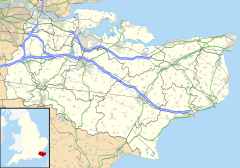Hythe, Kent facts for kids
Quick facts for kids Hythe |
|
|---|---|
| Market town and civil parish | |
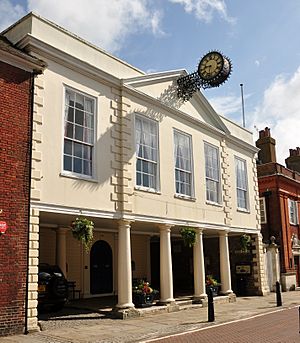 Hythe Town Hall |
|
| Population | 14,516 (2011) |
| OS grid reference | TR158350 |
| Civil parish |
|
| District |
|
| Shire county | |
| Region | |
| Country | England |
| Sovereign state | United Kingdom |
| Post town | HYTHE |
| Postcode district | CT21 |
| Dialling code | 01303 |
| Police | Kent |
| Fire | Kent |
| Ambulance | South East Coast |
| EU Parliament | South East England |
| UK Parliament |
|
Hythe (![]() i/ˈhaɪð/) is a historic town in Kent, England. It is located on the edge of Romney Marsh. The name Hythe comes from an Old English word. It means "haven" or "landing place." This name makes sense because Hythe was once a very important port town.
i/ˈhaɪð/) is a historic town in Kent, England. It is located on the edge of Romney Marsh. The name Hythe comes from an Old English word. It means "haven" or "landing place." This name makes sense because Hythe was once a very important port town.
Contents
History of Hythe
The town of Hythe has a long history. It was first mentioned in the Domesday Book in 1086. However, people lived in this area even earlier, during Roman times.
Hythe has many old buildings. You can see mediaeval and Georgian styles. There is also a church on a hill. It has parts built in the Saxon and Norman styles. Along the seafront, there is a Victorian promenade.
The Hythe Town Hall is a beautiful building. It was finished in 1794. It is built in the neoclassical style.
Hythe used to have a busy market in Market Square. Today, a farmers' market is held there twice a month. The town also has many sports clubs. These include gardening, horse riding, bowling, tennis, cricket, football, and sailing.
Hythe was one of the important Cinque Port towns. These were coastal towns in England that had special rights. They helped the King by providing ships and sailors. Hythe had a busy harbour. But over 300 years, the harbour filled with sand and mud. Now, it is gone. Hythe was a central Cinque Port. It was between Hastings and New Romney to the west. To the east were Dover and Sandwich.
In 1293, a French fleet came to Hythe. About 200 French soldiers landed. But the people of Hythe fought them. They killed all the soldiers. The rest of the French fleet then sailed away.
Sadly, the Black Death hit Hythe in 1348. The plague also reduced the population in 1400.
Hythe used to be home to the Mackeson Brewery. This brewery made Mackeson Stout, a famous type of beer. The brewery closed in 1968.
The Hythe Ranges is a military training area. It covers a large part of the Hythe shoreline. When red flags are flying, access to this area is restricted. This means you cannot go there.
Royal Military Canal and Martello Towers
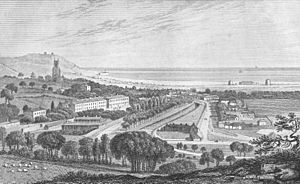
The Royal Military Canal is a famous landmark in Hythe. It runs along the northern edge of the marsh. This canal was built to protect England from a possible invasion. This was during the Napoleonic wars (1804-1815).
The canal is about 10 yards wide. It flows through the middle of Hythe. It then goes into the marsh. You can walk along its entire 26-mile length.
At the same time, Martello Towers were built. These towers were also to defend against Napoleon. In total, 74 towers were built between Folkestone and Seaford. The walls of these towers were very thick, up to 13 feet (4 meters). Each tower held 24 soldiers. They also had a large cannon on top.
Three Martello Towers still stand in Hythe. One was made into a house in the 1930s. You can see it along West Parade. The other two are on the beach. They are owned by the Ministry of Defence.
Castles Protecting Hythe
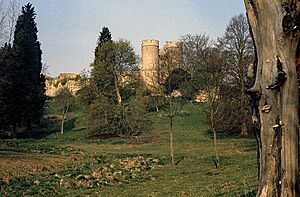
Hythe was once protected by two castles: Saltwood and Lympne. Saltwood Castle is named after the nearby village.
Saltwood Castle was once owned by the church. But in 1170, a famous event happened there. Four knights plotted to kill Thomas Becket. He was the Archbishop of Canterbury. The next day, they carried out their plan.
After this, Hythe came under the control of the King. Later, in 1575, Queen Elizabeth I gave the town control over its own affairs. The first mayor of Hythe was John Bredgman.
Cinque Port Court of Shepway
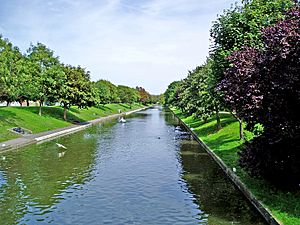
A large stone cross stands near Hythe. It marks a historic meeting place. This was where the Cinque Port towns held their court. It was called the "Court of Shepway." The cross was put there in 1923. It is also a memorial to those who served in the war.
The "lathe of Shepway" was an old name for south-east Kent. This area included Folkestone, Hythe, and Romney Marsh.
Romney, Hythe and Dymchurch Railway
Hythe is the starting point for the Romney, Hythe and Dymchurch Railway. This is a special miniature railway. It has steam and diesel trains that are one-third the size of regular trains.
The railway runs along the coast. It goes through Dymchurch and New Romney to Dungeness. The track is nearly 14 miles (23 km) long. It opened in 1927. During the Second World War, this railway helped transport parts for a special pipeline called Operation Pluto.
Government
Hythe is part of the Folkestone and Hythe area. This area elects a Member of Parliament (MP). The MP represents the people of Hythe in the House of Commons in London.
Places to Visit in Hythe
- Brockhill Country Park: A lovely park with walking trails and nature.
- Port Lympne Wild Animal Park & Gardens: A large animal park with many different species.
- St Leonard's Church: The historic church on the hill.
- Romney, Hythe and Dymchurch Railway: A fun miniature railway ride.
Sports and Fun
Hythe has a local football team called Hythe Town F.C.. They play at the Reachfields Stadium.
Theatre
The Folkestone & Hythe Operatic & Dramatic Society owns the Tower Theatre. This group puts on several plays and shows each year.
Local News
Hythe has local newspapers like the "Folkestone and Hythe Express." There are also free newspapers and local magazines. You can find news about Hythe online too.
For radio, Hythe has local stations like KMFM Shepway and White Cliffs Country. There is also Cinque Ports Radio 100.2FM.
Famous People from Hythe
Many interesting people have lived in or had connections to Hythe:
- The writer Elizabeth Bowen spent her childhood in Hythe.
- Saltwood Castle was home to Lord Deedes and later to art historian Kenneth Clark and his son Alan Clark.
- The famous novelist Daphne du Maurier lived in Hythe during the early years of the Second World War.
- Lionel Lukin is buried in Hythe. He is known for inventing the self-righting lifeboat.
- Francis Pettit Smith was born and grew up in Hythe. He invented the marine screw propeller.
- Charles Wakefield, 1st Viscount Wakefield was a great helper of Hythe. He founded the Castrol Oil Company.
- Actor Kenneth Colley, known for playing Admiral Piett in Star Wars, lives in Hythe.
See also
 In Spanish: Hythe (Kent) para niños
In Spanish: Hythe (Kent) para niños


